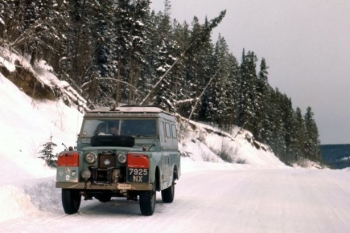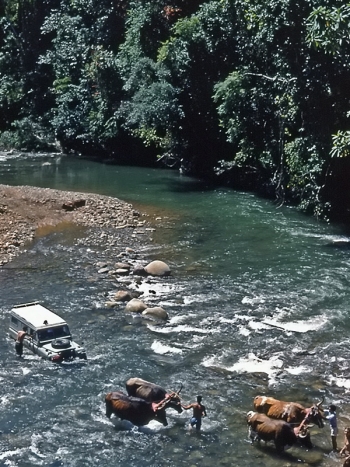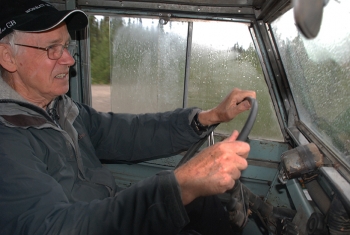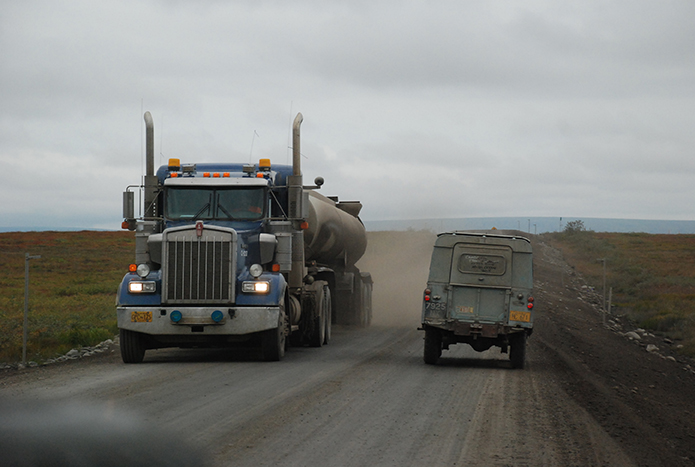There and back again: St John's alumnus returns to Alaska to finish epic journey
More than 50 years after setting out on an epic journey across both American continents, three University of Cambridge graduates, including Johnian Mike Andrews, successfully completed the final leg of their daring road trip – in the same Land Rover they used decades ago.
In 1960, a group of youthful Cambridge University graduates took a Land Rover on one of the world’s most challenging and adventurous road trips: from Tierra del Fuego at the southern tip of Argentina up the Pan-American Highway, heading for the Arctic Circle. The team may have been the first ever to drive the route.
After travelling through 17 different countries, the “Cambridge Trans-American Expedition” reached the town of Fairbanks in Alaska, the northernmost state of the US. Almost at their final destination, just 500 miles from the Arctic, their vehicle became stranded due to severe weather and a total lack of roads or tracks to drive on.
Forced to admit defeat, the adventurers sold their Land Rover to pay for a flight home to Britain, their epic journey of over 40,000 miles unfinished.
 Now, 55 years later, Mike Andrews, Martin Hugh-Jones and Ben Mackworth-Praed, all now in their late 70s, will return to finish what they started – in the very same Land Rover they used decades ago.
Now, 55 years later, Mike Andrews, Martin Hugh-Jones and Ben Mackworth-Praed, all now in their late 70s, will return to finish what they started – in the very same Land Rover they used decades ago.
Bristol-based Mike Andrews, who read Mechanical Sciences at St John’s College, Cambridge, in the late 1950s, wrote an article in 2010 for Land Rover Owner International Magazine, chronicling his adventures for the 50th anniversary of the expedition.
Amazingly, the vehicle was recognised from a photograph in the article by its current owner, based in Anchorage, Alaska, who suggested that they finish the journey.
“It was pretty derelict at the time”, Andrews said, “But after a lot of work, it is running well again, although it does show the scars of age – just like us”.
The expedition team are now determined to complete the last leg of their journey later this month. Setting out from Fairbanks, Alaska, on 8 August, Andrews and the team will drive 500 miles to Prudhoe Bay, on the edge of the Arctic Ocean, to reach their intended destination at last.
Andrews, 76, a retired television producer, filmed much of the original journey and intends to record the final leg for a programme to be broadcast by the BBC later this year. He said: “The Cambridge Trans American Expedition was the beginning of a career in film and television for me because on my return, at the age of 22, I sold two films - one to the BBC and another to ITV about our experiences”.
 Andrews will be joined by his fellow adventurers Professor Martin Hugh-Jones, 79, of Louisiana State University and Ben Mackworth-Praed, also 79, who wrote about the team’s original expedition in his book, A Year With Three Summers. Sadly, the team’s fourth original member, Andy Bacon, passed away before he could see the journey completed.
Andrews will be joined by his fellow adventurers Professor Martin Hugh-Jones, 79, of Louisiana State University and Ben Mackworth-Praed, also 79, who wrote about the team’s original expedition in his book, A Year With Three Summers. Sadly, the team’s fourth original member, Andy Bacon, passed away before he could see the journey completed.
The original expedition had a serious scientific purpose. Veterinarian Martin Hugh-Jones studied animal husbandry practices and livestock disease along the route. This study led to Hugh-Jones later making the important discovery of the mode of transmission of Foot-and-Mouth disease by aerosol, with the virus being sucked up from infected animals by evaporation into clouds and later rained out onto other cattle downwind.
The journey was a perilous passage. “No drive up the Pan-American Highway was simple” said Andrews, “In Patagonia it did not exist, and in Costa Rica there were no bridges, elsewhere it varied from single-track deep mud to sinking desert sand. Only about 2% of it was paved”.
By the time the team reached Costa Rica, they were already five months behind schedule mostly due to the Land Rover breaking down on the difficult terrain.
They crossed the infamous Darien Gap in the jungles of Panama by foot and canoe at the height of the rainy season, drove on railway track along embankments and bridges for over 20km without knowing if a train was coming, were towed out of a river in Costa Rica, had the paint sand-blasted off the Land Rover in high winds in Patagonia and traversed the Andes Mountains 12 times.
“The sheer difficulty of travel was considerable. The Land Rover basically disintegrated en route - we broke practically every part of it. By the time we got to Alaska the transmission had to have five major rebuilds” Andrews said.
 Even now, the trip from Alaska to the Arctic Ocean is not expected to be much easier. While road conditions have improved somewhat, the trip will take them across the Dalton Highway, a huge dirt track featured in the BBC’s “World’s Most Dangerous Roads”. The team will be accompanied by a small convoy of other vintage Land Rovers for much of the way, carrying expedition organiser Ed Angel and photo-journalist Michael Rudd, who will document the completion of this ambitious journey.
Even now, the trip from Alaska to the Arctic Ocean is not expected to be much easier. While road conditions have improved somewhat, the trip will take them across the Dalton Highway, a huge dirt track featured in the BBC’s “World’s Most Dangerous Roads”. The team will be accompanied by a small convoy of other vintage Land Rovers for much of the way, carrying expedition organiser Ed Angel and photo-journalist Michael Rudd, who will document the completion of this ambitious journey.
In his original brochure to raise funds for the expedition, Andrews wrote: “It is time for a new picture of the Americas as a whole to be brought to Europe...we feel we have a unique opportunity to capture during our trip the spirit of the lands. We are confident that by using modern equipment, our youthful enthusiasm, professional skill, and a willingness to endure a lack of the comforts of modern life, we can achieve our aim”.
Now, over five decades later, the septuagenarian adventurers hope to finish what they began.
“You could call it the trip of a lifetime”, Andrews said.
Update:
The Cambridge Trans-American Expedition reached its goal of the Arctic Ocean today (10th August 2015) - almost 55 years after it set out. Driving the original 1960 Land Rover, Martin Hugh-Jones, Ben Mackworth-Praed, and Mike Andrews arrived at the shore of the Beaufort Sea in freezing temperatures and steady rain at Endicott Island, Prudhoe Bay, after driving 500 miles in 2.5 days from Fairbanks, Alaska.
Mike Andrews said, "It was amazing, not just to be at the wheel our old vehicle again, but with my original companions to complete the final leg of our voyage from Ushuaia, Tierra del Fuego, Argentina - which we had to abandon in December 1961 because the roads to the Arctic Circle were closed by snow."
The Dalton Highway, up which they drove is notorious for its danger, and was only built in 1974 to enable the construction of the Trans-Alaska Pipeline carrying oil from the Alaska North Slope to Valdes and the Pacific.Their Land Rover is now owned by Eddie Angel of Anchorage, Alaska who restored its mechanics but left the bodywork in its original state. "Like us it shows its age - but just keeps on going." Andrews said.
On their journey they were accompanied by eight other Land Rovers owned by local enthusiasts, mostly driving 1960s models. For their final camp by a river at Deadhorse, they braved pouring rain and freezing temperatures.

All images by Mike Andrews.